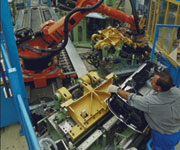 |
| DOWN THE LINE Fleet owners may see steels impact reflected in higher equipment prices. (Photo courtesy of DaimlerChrysler AG.) |
This years sharp escalation in steel prices has manufacturers of work trucks and heavy construction equipment keeping a watchful eye on their futures.
"Our product prices are directly affected by the price of steel," says Margaret A. Tue, purchasing manager for Stellar Industries Inc. The Garner, Iowa-based producer of truck-mounted implements reports a 30% increase in raw-steel costs since January, with no signs of price relief in the near-term.
The rising cost of steel in the U.S.some call it the fastest and strongest spike in 25 yearsis cutting into the already-slim profit margins of domestic equipment manufacturers, which often have trouble passing higher production costs along in a very competitive marketplace. The potential cost squeeze is casting a foreboding cloud over an otherwise bright year that promises to be the best since record sales dropped off in mid-2000 (ENR 1/19 p. 23).
Caterpillar Inc. says it is watching the steel market "very closely" and has "a number of efforts under way" to contain prices, says Peoria, Ill.-based spokeswoman Lori T. Porter, who would not offer further comments.
General Motors-Isuzu Commercial Truck, Cerritos, Calif., already has established 2005 truck prices, says Todd Bloom, vice president of marketing. "We dont see todays steel pricing having an effect." But that could change in the future, he adds.
|
VIEW MORE ARTICLES FROM FIRST QUARTERLY COST REPORT |
| Summary: Inflation's Sneak Attack |
| Steel: Industry stunned by huge price hikes |
| Labor: Costs hinge on settling union dispute |
| Indexes: Steel prices jolt building costs |
| Methodology: What drives inflation |
|
VIEW RELATED DATA |
| Metal Costs in Heavy Equipment |
Analysts indicate that producers may attack the problem by cutting down on dealer rebates, which now are plentiful, or restructuring operations to offset steel costs. However, consolidation already has forced lean manufacturing on many producers. With margins thin and demand rising, manufacturers may be tempted by the third option of pushing costs toward the buyers in the form of higher prices for the products.
"The manufacturers may say, Lets shake the bushes and find out what we can do to cut costs. Or say, Weve eliminated everything to the bone and were going to pass this along in our price increase," says Stephen Haggerty, New York City-based machinery analyst for Merrill Lynch. "Its just a question of where in the value chain it gets absorbed."
Steel is a big issue for manufacturers of trucks and heavy construction equipment because it constitutes a heavy chunk of their overhead costs (see table). Likewise, suppliers of components, such as engines, axles and hydraulic cylinders, also are feeling the supply crunch. "Steel is not our biggest purchased material, but we are still fortunate to have negotiated rates with our suppliers," says Jim Cartwright, spokesman for Parker Hannifin Corp., a $6.4-billion producer of equipment instrumentation and hydraulic parts.
Smaller firms with limited resources often may have no choice but to pass the buck. "It puts us at a huge [competitive] disadvantage," says K. Erich Rose, owner of truck body upfitter K.E. Rose Co., Huber Heights, Ohio. For example, Rose says the cost of stainless-steel dump bodies has increased by $1,500, or 33%, since January.
Some industry analysts say that if steel costs continue to rise, buyers may see 3% to 5% price increases by the year-end on new trucks and equipment.
|
